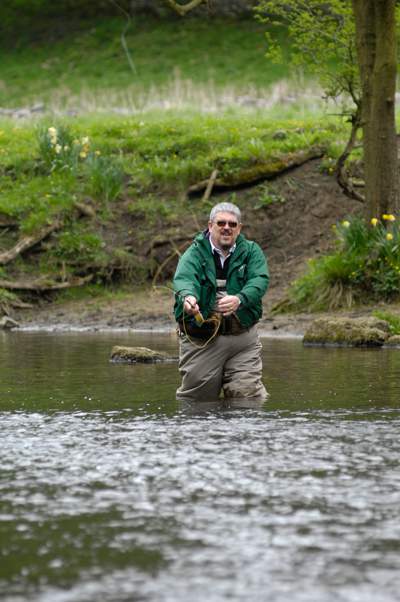The Science of Casting
Unlike other casting methods, fly fishing can be regarded as a method of casting line instead of lure. Non-flyfishing methods depend on a lure's weight to pull line out of your reel throughout the forward motion of the cast. By design, a fly is simply too light for being cast, and thus simply follows the unfurling of a properly cast fly line, and that is heavier and tapered and therefore more castable than lines used in other forms of fishing.
 The physics of flycasting can be described through the transfer of impulse, the product of mass and speed through fly fishing rods from base to top and from the transfer of impulse with the fly line all the way to the tip of the leader. Because both the rod as well as fly line are tapered the smaller amount of mass will reach high speeds when the waves in rod and line unfurl. The waves that travel with the fly line are called loops. Determining factors in reaching the very best speeds are the basal frequency of a rod and the transfer of the speed through the tip of the rod to the fly line. In the mean time the rod tip reaches its highest velocity the direction from the cast is determined.
The physics of flycasting can be described through the transfer of impulse, the product of mass and speed through fly fishing rods from base to top and from the transfer of impulse with the fly line all the way to the tip of the leader. Because both the rod as well as fly line are tapered the smaller amount of mass will reach high speeds when the waves in rod and line unfurl. The waves that travel with the fly line are called loops. Determining factors in reaching the very best speeds are the basal frequency of a rod and the transfer of the speed through the tip of the rod to the fly line. In the mean time the rod tip reaches its highest velocity the direction from the cast is determined.
The type of cast used when fishing varies according to the conditions. The most common cast is the forward cast, where the angler whisks the fly into the air, back over the shoulder until the line is nearly straight, then forward, using primarily the forearm. The objective of this motion would be to "load" (bend) the rod tip with stored energy, then transmit that energy to the fly fishing line, resulting in the fly line (as well as the attached fly) being cast for an appreciable distance. Casting without landing the fly in the water is called 'false casting', and may even be used to pay out line, to dry a soaked fly, or to reposition a cast. Other casts are the roll cast, the single- or double-haul, the tuck cast, and the side- or curve-cast.
Dropping the fly onto the water and its subsequent movement on or beneath the surface is considered one of fly fishing's most difficult aspects; the angler is attempting to cast in such a way the line lands smoothly in the water and so the fly appears as natural as possible. At a particular point, if a fish doesn't strike, depending upon the action of the fly in the wind or current, the angler picks up the line in making another presentation. Then again, if a fish strikes, the angler pulls in line while raising the rod tip. This "sets" the hook in the fish's mouth. The fish is played either by hand, where the angler continues to hold the fly line in one hand to manage the tension applied on the fish, or by reeling up any slack in the line and then he will using the hand to act as a drag on the reel. Most recent fly reels have an adjustable, mechanical drag system to regulate line tension during a fish's run.
Beginners usually point with the rod to where they want to throw, but the movement of the hand has to be a controlled speed-up and then come to an abrupt stop. The rod will then start to unfurl and the tip of the rod will reach a top speed in the required direction. The high speed of the rod tip toward the target gives the impulse to make the cast, the abrupt stop and retreat of the rod tip is crucial for the formation of a loop. Experienced fishermen also improve the speed of the line leaving the rod tip by a method called hauling, applying a quick fast pull with the hand holding the line. At the end of the cast when the line is stretched the line as a whole will still have speed and the fisherman can let some extra line through his fingers making a false throw, either forward or backward or to complete the cast and start fishing.
One can find a great number of special casts meant to evade problems like trees behind the angler (roll cast), the pulling of the line on the fly by the action of the stream, or in making the fly land more softly.
Spey Casting
Spey casting is a casting technique utilised in fly fishing. Spey casting requires a longer, heavier two-handed fly rod, referred to as a Spey rod. Spey casting is essentially a large roll cast, developed on the Scottish River Spey where high banks do not allow space for the standard back cast.
Spey casting is used for fishing large rivers for salmon and large trout just like steelhead and sea trout. Spey technique can be used in saltwater surf casting. All of these situations require the angler to cast larger flies long distances. The two-handed Spey technique allows more powerful casts and avoids obstacles on the shore by keeping most of the line in front of the angler.



















